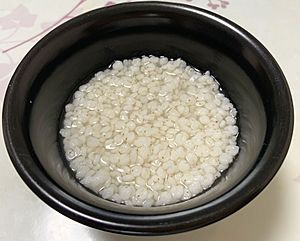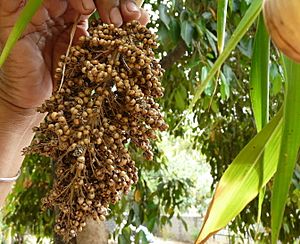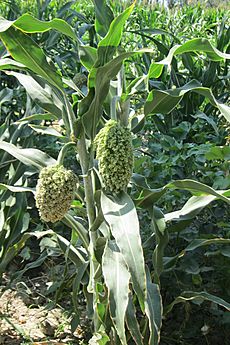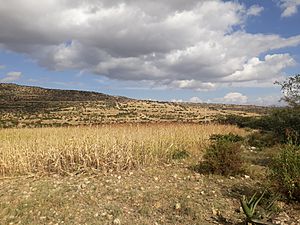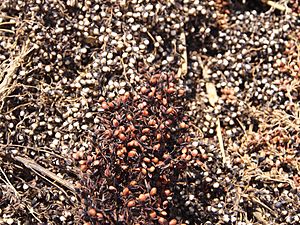Great millet facts for kids
Quick facts for kids Great millet |
|
|---|---|
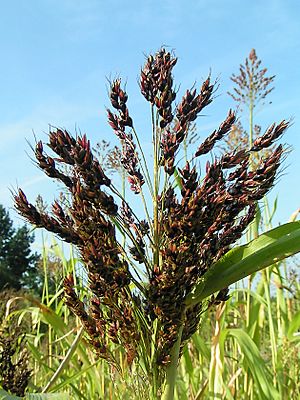 |
|
| Scientific classification | |
| Genus: |
Sorghum
|
| Species: |
bicolor
|
| Synonyms | |
|
List
|
|
Sorghum bicolor, often called sorghum, is a type of grass. People grow it for its grain. This grain is used for human food, animal feed, and to make ethanol. Sorghum first grew in Africa. Now, it is grown in many warm, sunny parts of the world.
Sorghum is the fifth most important cereal crop globally. It comes after rice, wheat, maize (corn), and barley. In 2018, about 59.34 million metric tons were grown. S. bicolor usually grows for one year, but some types can grow for many years. It grows in groups and can reach over 4 meters (13 feet) tall. The grains are small, about 2 to 4 millimeters wide. Some types, called Sweet sorghums, are grown for animal food, syrup, or ethanol. These are taller than the types grown for grain.
Sorghum bicolor is the main type of sorghum that people grow. Its wild relatives belong to the plant group called Sorghum.
Contents
Growing Sorghum
Many countries grow S. bicolor, including Nigeria, India, Mexico, and the United States. Sorghum can grow in many different conditions. It handles various temperatures, high places, and even unhealthy soils. It can also recover after a dry spell.
Sorghum is very good at surviving droughts because of five special features:
- It has a large root system compared to its leaf size.
- When it's dry, it rolls its leaves to save water.
- If the drought continues, it goes into a resting state instead of dying.
- Its leaves have a waxy coating that protects them.
- It uses a special way to make food called C4 carbon fixation. This means it needs only one-third of the water that other plants need.
History of Sorghum
The oldest signs of sorghum were found in Nabta Playa in Egypt, around 8000 BC. These were wild types of sorghum. Scientists believe sorghum was first grown by people in the Niger River valley between 7000 and 5000 BC.
Botanists divide sorghum into five main types:
- durra: developed in India.
- guinea: a West African type that needs a lot of rain.
- caudatum: grown by Nilo-Saharan people in Africa.
- kafir: a type that can handle dry weather, grown in Southern Africa.
- bicolor: the most common type of grain.
Sorghum grain has a tough outer layer that must be removed before eating. In the past, this was done by hand using a mortar and pestle. In the United States, people worked hard to clean the grain and turn it into flour. Benjamin Franklin first wrote about sorghum in the United States in 1757.
Some types of sorghum were important for making sugar. In the 1800s, the price of sugar was going up. People in the United States wanted a sugar plant that could grow in northern states. "Chinese sugar-cane," as it was called, was seen as a good option.
In 19th-century Ethiopia, durra was often the first crop planted on new land. This was because it did not need much plowing. Its roots also helped make the soil better and break it up.
In old European writings, the word "millet" was sometimes used for both pearl millet and sorghum. In Portuguese, milho could mean both maize (corn) and sorghum. This was because they looked similar when growing. However, sorghum produces a tassel of exposed grains, while maize has a husk. This can make it hard to know which crop old texts are talking about.
How Sorghum is Used
Sorghum is grown all over the world today. Its grain is used for human food, to make drinks, for animal feed, and for bio-based ethanol. Sorghum grain does not contain gluten. It also has healthy compounds not found as much in other grains.
Food Uses
| Nutritional value per 100 g (3.5 oz) | |
|---|---|
| Energy | 1,418 kJ (339 kcal) |
|
74.63 g
|
|
| Dietary fiber | 6.3 g |
|
3.30 g
|
|
|
Protein
|
11.30 g
|
| †Percentages estimated using US recommendations for adults. | |
In many parts of Asia and Africa, sorghum grain is used to make flat breads. These breads are a main food for many cultures. In Western India, popped sorghum grains are a popular snack.
In India, sorghum is called jwaarie, jowar, or jola. It is a main food source in states like Rajasthan and Maharashtra. An Indian bread called bhakri or jolada rotti is made from this grain.
In Tunisia, sorghum is called droô. A traditional porridge is made from ground sorghum, milk, and sugar. This dish is a common breakfast in winter.
In Central America, tortillas are sometimes made with sorghum. While corn is usually preferred, sorghum tortillas are common in Honduras. White sorghum is best for making tortillas.
Sweet sorghum syrup is sometimes called molasses in the United States. However, it is not true molasses.
In Southern Africa, sorghum is used with milk, sugar, and butter to make Maltabella. This is a type of millet porridge.
Drinks
In China, sorghum is called gaoliang. It is used to make a clear alcoholic drink called baijiu. One famous type is Maotai. On the island of Kinmen in Taiwan, plain sorghum is used to make sorghum liquor.
In several African countries, including Zimbabwe and Nigeria, red and white sorghum are used to make traditional beer. Red sorghum gives the beer a pink-brown color.
Biofuel
In Australia, South America, and the United States, sorghum grain is mostly used for animal feed. It is also used more and more in plants that make ethanol.
In some countries, the stalks of sweet sorghum are used to make biofuel. The juice is squeezed out and then turned into ethanol. Researchers are looking for the best types of sorghum for making ethanol from its leaves and stalks.
Other Uses
Sorghum is also used to make traditional corn brooms. The leftover stalks of the sorghum plant can be used to make a decorative building material called Kirei board.
Sorghum in Farming
Sorghum is used as feed and pasture for farm animals. However, it can be harder for animals to digest than corn. Studies show that processing sorghum by steaming it helps animals gain more weight. For hogs, sorghum can be a better feed choice than corn if prepared the same way.
New types of sorghum and better farming methods have helped grow more sorghum. In India, these improvements have freed up a lot of land. The International Crops Research Institute for the Semi-Arid Tropics works with others to create better types of crops, including sorghum. They have released many improved sorghum varieties.
Sorghum as a Weed
Wild types of S. bicolor, especially Sorghum × drummondii, are known as shattercane. These can grow as weeds in fields.
Research on Sorghum
Scientists are working to make sorghum plants more resistant to cold weather. They are also trying to understand how sorghum survives droughts so well. This research is important because corn, another major crop, has become more expensive.
Sorghum can also be used as a replacement for corn in the diet of dairy cattle. Research shows that sorghum can have higher nutritional value for dairy cattle than corn. How the grain is processed also matters for getting the most nutrition. Feeding steamed sorghum has led to more milk production.
More research is happening to see if sorghum can help feed the growing world population. Sorghum is good at handling dry and hot conditions. Its different types make it strong against pests and diseases. It is also very good at turning sunlight into energy and using water efficiently. These qualities make it a promising food source for the future. Many groups, like Purdue University and the University of Nebraska–Lincoln, are studying Sorghum bicolor. The University of Queensland is working to make sorghum even more resistant to plant diseases.
Another research area for sorghum is as a biofuel. Sweet sorghum stalks have a lot of sugar, which can be turned into ethanol. The plant material can also be burned to make charcoal, gas, and bio-oil.
Sorghum's Genetic Code
The complete genetic code (genome) of S. bicolor was mapped between 2005 and 2007. It usually has 20 chromosomes. Scientists think it might have started from a plant with four sets of chromosomes. Its genome size is about 800 million base pairs.
Pests and Diseases
Sorghum can be attacked by a parasitic plant called Striga hermonthica. This parasite causes a lot of damage to the crop. The European corn borer (Ostrinia nubilalis) came to North America because of infested sorghum broom corn.
Here are some pests that attack sorghum crops in northern Mali:
- Atherigona soccata (sorghum shoot fly): Its larvae cut the growing part of the sorghum leaf.
- Agonoscelis pubescens: Also known to be a sorghum pest.
- Busseola fusca (maize stem-borer): This moth attacks maize and sorghum, especially in higher places.
- Chilo partellus (spotted stem-borer): This pest attacks sorghum and maize.
- Contarinia sorghicola (sorghum midge): The larvae of this tiny fly eat the developing seeds of sorghum.
- Melanaphis sacchari (sugar cane aphid): This aphid attacks sorghum plants.
Pests like Sitophilus zeamais (maize weevil) and Sitotroga cerealella (Angoumois grain moth) attack sorghum and maize that are stored.
See also
 In Spanish: Sorghum bicolor para niños
In Spanish: Sorghum bicolor para niños


